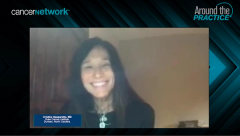
Patient Case #1: A 75-Year-Old Woman With Newly Diagnosed MM
Experts review the case of a 75-year-old woman with newly diagnosed multiple myeloma and discuss treatment selection, continuation, reduction, and duration.
Episodes in this series

Transcript:
C. Ola Landgren, MD, PhD:Patient case No. 1, a 75-year-old lady, newly diagnosed multiple myeloma, with mild or persistent low back pain and also progressive fatigue. Past medical history is stage 2 chronic kidney disease, cardiac dysrhythmia, medically controlled hypertension, diabetes controlled with diet and exercise, and anemia. There are several things going on here. The performance status is 1, so that’s pretty good, and the revised-ISS [International Staging System] is stage 2 on a scale from 1 to 3. Then, there is an 11;14 translocation. This patient is deemed transplant ineligible by the treatment team. I ask the audience here to vote. How would you treat this patient: DRd [daratumumab, lenalidomide, dexamethasone], Rd [lenalidomide, dexamethasone], Dara-CyBorD [daratumumab, cyclophosphamide, bortezomib, dexamethasone], VRd [bortezomib, lenalidomide, dexamethasone]-lite, or KRd [carfilzomib, lenalidomide, dexamethasone]? Please go ahead and vote. Let’s see here. A is DRd and D is VRd-lite.
When you initiate the triplet regimen for a newly diagnosed patient, do you continue the triple therapy, or do you switch to maintenance? Do you typically continue, do you typically switch to a single drug, or do you reduce to a doublet, or is there really no standard practice you follow? Please go ahead and vote. You typically go to a single drug. That’s what I do…. There are more votes, A, some continue, and some say here, “We have no standard practice.” But the winner is, go to a single drug. I think you could argue for all of them, and there are probably individual factors for individual patients.
Next, if you do not continue the triplet therapy, what’s the rationale for reducing to a double or single agent? Is it feasibility/patient preference, is it safety and toxicity, that you want to save drugs for later, or other reasons? The poll results show safety and toxicity, and then you want to save drugs. In my practice, I think a lot of my patients are also asking for feasibility. But safety/toxicity, obviously if there are patients who are in this older category, that probably is one of my main factors as well and that could be others’ as well.
What’s your approach to determine the duration of treatment for your patients with myeloma? Treat to progression, treat to a prespecified response, treat until the patient requests a drug holiday, treat to a predetermined fixed duration, or treat until tolerability issues arise? The winner here is A, which is treat until progression, and then B and E are treat to a prespecified criteria and treat until tolerability issues arise.
Transcript edited for clarity.
Newsletter
Stay up to date on recent advances in the multidisciplinary approach to cancer.





















































































